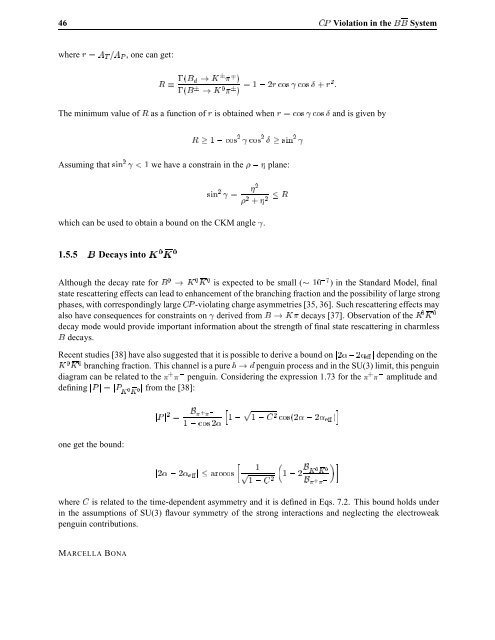Violation in Mixing
Violation in Mixing
Violation in Mixing
Create successful ePaper yourself
Turn your PDF publications into a flip-book with our unique Google optimized e-Paper software.
46 �È <strong>Violation</strong> <strong>in</strong> the �� System<br />
where Ö � �Ì ��È , one can get:<br />
Ê � �� � à ¦ � §<br />
� ¦ � Ö Ó× Ó× Æ Ö �<br />
� Ã � ¦<br />
The m<strong>in</strong>imum value of Ê as a function of Ö is obta<strong>in</strong>ed when Ö � Ó× Ó× Æ and is given by<br />
Ê � Ó× Ó× Æ � ×�Ò <br />
Assum<strong>in</strong>g that ×�Ò � we have a constra<strong>in</strong> <strong>in</strong> the � � plane:<br />
×�Ò �<br />
�<br />
� �<br />
which can be used to obta<strong>in</strong> a bound on the CKM angle .<br />
1.5.5 � Decays <strong>in</strong>to à Ã<br />
Although the decay rate for � � Ã Ã is expected to be small (� � ) <strong>in</strong> the Standard Model, f<strong>in</strong>al<br />
state rescatter<strong>in</strong>g effects can lead to enhancement of the branch<strong>in</strong>g fraction and the possibility of large strong<br />
phases, with correspond<strong>in</strong>gly large �È -violat<strong>in</strong>g charge asymmetries [35, 36]. Such rescatter<strong>in</strong>g effects may<br />
also have consequences for constra<strong>in</strong>ts on derived from � � Ã� decays [37]. Observation of the à Ã<br />
decay mode would provide important <strong>in</strong>formation about the strength of f<strong>in</strong>al state rescatter<strong>in</strong>g <strong>in</strong> charmless<br />
� decays.<br />
Recent studies [38] have also suggested that it is possible to derive a bound on � « «�« � depend<strong>in</strong>g on the<br />
à à branch<strong>in</strong>g fraction. This channel is a pure � � � pengu<strong>in</strong> process and <strong>in</strong> the SU(3) limit, this pengu<strong>in</strong><br />
diagram can be related to the � � pengu<strong>in</strong>. Consider<strong>in</strong>g the expression 1.73 for the � � amplitude and<br />
def<strong>in</strong><strong>in</strong>g �È � � �È Ã Ã � from the [38]:<br />
one get the bound:<br />
� Ê<br />
�È � � � � Ô � �<br />
� Ó× « «�«<br />
Ó× «<br />
�<br />
� « «�«� ��Ö Ó× Ô<br />
�<br />
�<br />
� Ã Ã<br />
� � �<br />
where � is related to the time-dependent asymmetry and it is def<strong>in</strong>ed <strong>in</strong> Eqs. 7.2. This bound holds under<br />
<strong>in</strong> the assumptions of SU(3) flavour symmetry of the strong <strong>in</strong>teractions and neglect<strong>in</strong>g the electroweak<br />
pengu<strong>in</strong> contributions.<br />
MARCELLA BONA<br />
�<br />
��















